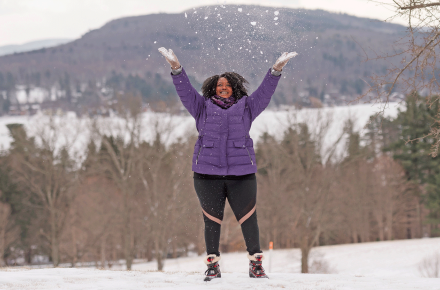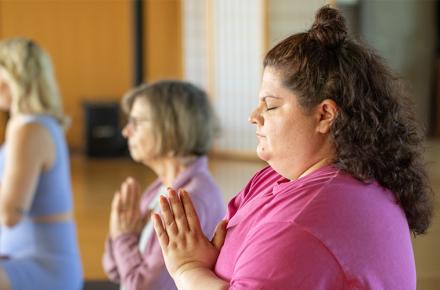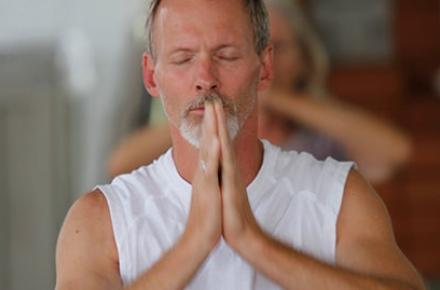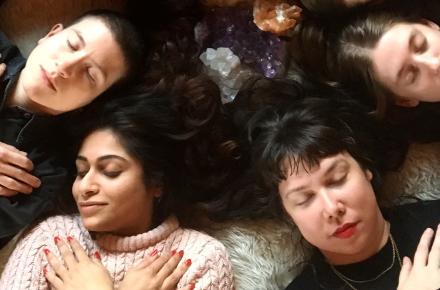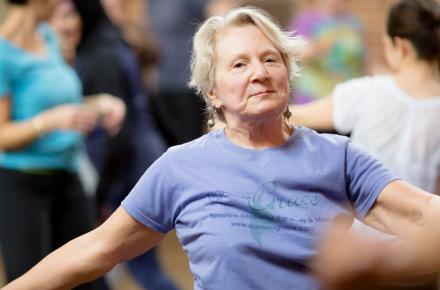Ryan Miller’s Five Tips for Starting a Mindful Running Practice

The first time Ryan Miller did yoga, he had a mini epiphany: Despite having years of competitive running under his belt, his body awareness was actually not all that great.
“A lot of athletes, when they try yoga, are overwhelmed at how tight they are,” Ryan says. “What hit me was how little I had been paying attention to what I was doing physically. I was drawn in by how specific and precise the alignment was.”
At first, he couldn’t even sit cross-legged in Easy pose. As he continued to practice, however, Ryan not only got more in touch with the way his body worked, he also began to reap the deeper benefits of yoga—and apply them to his races.
“The mental part of running is absolutely huge,” he says. “There’s all this mind chatter—Am I on pace? Am I off pace? What place are my teammates in? It’s taking away energy from the body that you need in order to go faster. I use yoga principles to simplify what’s going on in the mind, so I can get laser focused on the task at hand and eliminate the mental chaos.”
Ryan’s Running for Yogis program combines elements of his varied background, including his Kripalu Yoga Teacher Training, 13 years as a product developer for New Balance, study with mentors like Danny Dreyer (creator of ChiRunning®), and his personal experience as a runner—starting when he was just six or seven years old.
“The first thing that attracted me to running was how it was reliant on me to succeed,” Ryan recalls. “Because of when my birthday falls, I was always younger and smaller than the other kids, and in football or basketball, I had to rely on someone to pass me the ball. With running, I could be independent.”
His high school track coach emphasized a regimented training program based on monitoring heart rate, but at Fitchburg State University in Massachusetts (where Ryan was a five-time all–New England award winner), his coach encouraged his runners to shift the focus from hitting marks to listening to their bodies. That mindset became increasingly important for Ryan as he got more involved with yoga and began to approach running as a mindfulness practice.
“Running mindfully means focusing on how you feel, your breath, your arm swing, your hip stride,” he explains. “I call it ‘Runasana’—the pose of running. With mindful running, you’re paying more attention to what you’re doing—whether it’s how you’re breathing, the components of your technique, or your surroundings—and less attention to timing and results. The focus is on the process versus the end result.
“In high school and through the first two years of college, I would get so mad when I didn’t hit my goals, because I was so obsessed with the results. But when I started to enjoy the process, the results were way better. My last race in college, qualifying for the Nationals, I ended up running the easiest and one of the fastest races of my life. I felt like I was floating. When you get into that flow state, that’s when peak performance happens.”
Ryan took Kripalu Yoga Teacher Training in the summer of 2008, at age 26; he remembers knowing immediately that this was exactly where he was supposed to be. What resonated most with him was the lack of judgment among both students and teachers. “The focus on being compassionate to yourself and others, and the emphasis on doing what’s right for you and your body, was so powerful, especially coming from this sports culture in which people are always telling you what’s best for you,” he says. He integrated yoga and mindfulness into his work at New Balance, from leading meditation in meetings and teaching a yoga class for co-workers to helping design styles for the Minimus line—flatter, thinner shoes that keep runners more connected to the earth and to their own movement.
Ryan recently left New Balance and moved from Massachusetts to Cincinnati, Ohio, with his wife and daughter. He teaches workshops on yoga for stress reduction and performance, offers online instruction at ryanmilleryoga.com, and helps individual clients develop a sustainable daily running practice to enhance relaxation and focus.
If starting a running practice is on your list of intentions for the new year, try Ryan’s tips for finding your stride.
First, figure out what you want to get out of your running practice. Are you aiming to run competitively? Are you a talented high school runner with hopes of getting an athletic scholarship? If you want to start running for health reasons, pin down your goal—whether it’s losing weight, lowering your blood pressure, or increasing your respiratory capacity.
Whatever your goal is, craft a plan to get there. Mark specific training milestones that you want to reach along the way, or, if you’re developing a more relaxed practice, focus on figuring out what feels best and safest for your body. (Here’s where guidance from an expert like Ryan can be really helpful, so you can correct any misalignments and unhelpful habits.)
Establish a regular routine. How often you run depends on why you’re running. If your goal is to run a marathon, you’ll need to train five or six days a week. If you simply want to enjoy running as a form of stress relief and a way to get outside, a couple times a week is fine. “Two days a week is probably the minimum,” Ryan says. “It’s like playing an instrument—you need to get some practice in so you don’t go backwards.”
Never power through a run. “Like a lot of things, powering through running feels great at first, because the body releases endorphins that kill the pain, but an hour later, your knee hurts, your lower back hurts, your Achilles hurts,” Ryan says. To gauge whether you’re pushing too hard, pay attention to the breath. As soon as you lose focus on the breath, that’s when you get injured, Ryan says.
Stay in the moment. “No matter the goal, focus on the process itself,” Ryan says. “If you’re running for fun and to spend time in nature, your focus might be on the beauty of your surroundings. If you’re looking to run your fastest 5K, stay immersed in how the run feels in your body—not your favorite song that you’re listening to or anything other than that moment, that workout. When you eliminate the noise in your mind, you can completely focus on the task at hand, whether it’s athletics, relationships, or anything else in life.”
Find out about Ryan Miller’s Running for Yogis program at Kripalu.
© Kripalu Center for Yoga & Health. All rights reserved. To request permission to reprint, please email editor@kripalu.org.


























